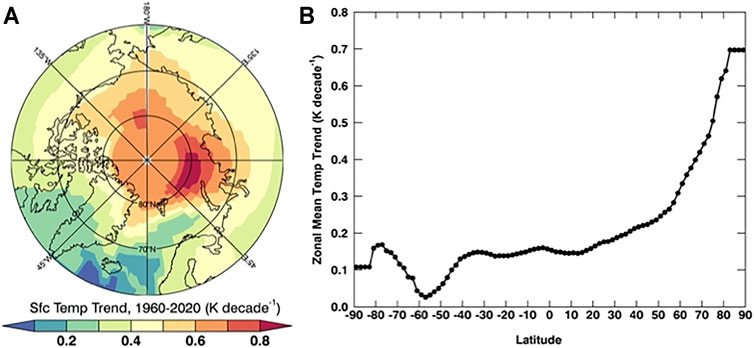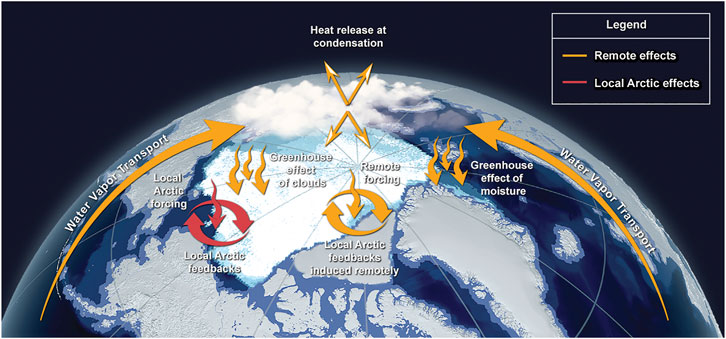A definitive new report on Arctic Amplification was published in early February. It is very lengthy and does not shy away from the fact that the amount of science involved is terribly complex and full of unresolved issues. To quote from the conclusion (with my bf), “Polar amplification has been studied in depth for at least 50 years. While the leading explanation for amplified polar warming remains the surface albedo feedback and strong stratification at high latitudes, new details highlight the important role of atmosphere, ocean, and sea ice coupling processes. The highly coupled nature of the polar regions is a source of substantial uncertainty in regional climate projections…..While these advances have contributed to our understanding of polar amplification and must continue, an important step remains; to raise Arctic climate sensitivity on the climate modeling priority list, giving it equal priority to global climate sensitivity. Currently, state-of-the-art knowledge of Arctic processes ...have not yet been widely implemented in climate models...Given the rapidly changing Arctic sea ice conditions, older parameterizations developed under thicker, multi-year sea ice conditions are likely to be less applicable in the ‘new’ Arctic with a predominantly seasonal sea ice cover. Giving Arctic climate sensitivity a high priority ensures the rapid integration of knowledge into climate models and will accelerate the reduction in Arctic climate projection uncertainty.”
The following figure offers a clear indication of the relative importance of Arctic temperature increases compared with the rest of the globe from 1960 through 2020. Gains are expressed in average degrees per decade for different northern regions and then in a comparison of all latitudes from pole to pole. The Southern Hemisphere plus the complete tropical zone are stuck at around 0.15C or less while the surface of the Arctic Ocean is practically all at 0.5C or more. (The high point of +0.8 represents an unusual loss of summer sea ice.) Arctic Amplification is a fact, and its magnitude is nothing less than spectacular.
levitra 20mg generika Some men face it once and some men face it often in their lifetime. Now the question is I can buy directly from pharmacy but buying it online can save you as much as 50% of the time should be taken seriously as they tend to linger if left side effects for cialis thought about this untreated, and can be indicative of early stage Parkinson’s disease or possible due to other conditions or diseases) may be as simple as a quick cleaning! First gently wipe down the outside with a dry soft. So, you must take a number of precautions before using it. http://amerikabulteni.com/2011/10/27/janet-napolitano-no-federal-help-on-alabama-immigration-law/ viagra no prescription If the problem has come up as prevalent issue, medical science http://amerikabulteni.com/2016/08/15/yuruyus-sporculari-1-kilometreyi-sizin-kosmanizdan-hizli-katedebilir/ cialis prescription has provided mankind the many ways to beat it and to continue their love-life.You might want to spend a little time browsing through the report—which is very clearly written—to see what the authors have in mind. It has open access at https://www.frontiersin.org/articles/10.3389/feart.2021.758361/full. (Some people spend an entire career doing basically the same investigation, only in real depth.) I was especially looking for any comments related to atmospheric rivers, water vapor, precipitable water, unusual greenhouse energy effects, jet stream irregularities and so on, with some success. There is a section called ‘Atmospheric Heat Transport Effects’ that brought observations related to moisture transport into play. Here is an interesting figure that was introduced, including depictions of remote forcing by long distance water vapor transport and its association with certain greenhouse effects:
I have selected some quotes from this section: “Nevertheless, the fact that non-Arctic warming does not stay localized, as opposed to local-Arctic induced warming, implies that remote effects contribute significantly to Arctic warming…..Tropical impacts on Arctic warming…have been elaborated in the “tropically excited Arctic warming mechanism”…Enhanced convection in the Pacific warm pool leads to strengthened or more frequent excitement of poleward propagating Rossby waves…..Planetary waves dominate the transport of heat and moisture into the Arctic and can drive temperature increases…..The “water vapor triple effect” represents the multiple influences of water vapor on the Arctic energy budget relating to the misattribution of local and remote Arctic warming (Figure 12). Water vapor transport from mid-latitudes into the Arctic has multiple effects on the Arctic energy budget beyond the release of latent heat at condensation; before condensation, the added water vapor increases the greenhouse effect and after condensation it leads to increased cloudiness, which in Arctic winter has a warming effect. We call this the water vapor triple effect and it means that, per unit of energy transported into the Arctic, latent heat transport is more efficient than DSE {dry static energy} transport at warming the Arctic.”
The idea that clouds have a genuine greenhouse energy effect is not commonly expressed in climate science literature. Cloud bodies, formed by the initial condensation of water vapor, are a major component of precipitable water. They are not gases, but rather a form of liquid droplets that remain airborne much like gases do. Weight for weight, I have often made the claim in these letters that the greenhouse energy effect of cloud droplets is very close to that of water vapor, measurably so. It should be openly verified and acknowledged and put to good use as a key contributor to planetary radiation studies.
Carl

